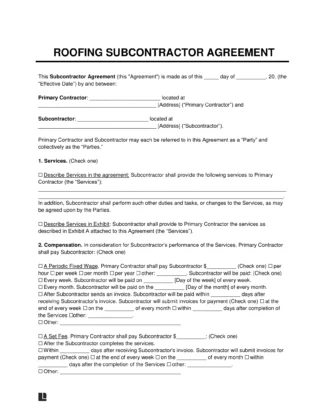
Use a roofing subcontractor agreement to establish guidelines with your subcontractor performing roof repairs and installations.

Published October 4, 2023
Written by Sara Hostelley | Reviewed by Brooke Davis
A roofing subcontractor agreement lays out the terms of employment between a general contractor for a construction project and a roofer to whom they allocate roof repairs, replacements, cleaning, installations, or siding.
The agreement should detail the roof specifications and the roofer’s responsibilities, including who is accountable for employees, materials, equipment, travel, and other liabilities.
Roofers are often hired as part of a greater construction project on a contract basis for an array of services they offer, including:
Hiring a roofing subcontractor who can be trusted to deliver a high-quality standard is essential as a general contractor. Their work will reflect on your reputation with the customer and for future jobs.
You may need to hire a few different types of roofing contractors, depending on the nature of the job that requires a roofer. The most common include:
Roofing subcontractor agreements may vary depending on the kind of project for which a roofer is required and the business itself.
A roofing subcontractor agreement breaks down what is expected of both sides, detailing the work the roofer must perform to complete the job and the contractor’s compensation.
You can hold the other side to their agreement and enforce it legally with a signed agreement. It also clarifies for both parties how the contract may be terminated and at what time, if need be.
There are a few important standards to include in a roofing subcontractor agreement:
Determining which party will be held accountable for roofing materials, equipment, travel, employees, and any additional liabilities is crucial.
Download the roofing subcontractor agreement template, available in PDF and Word.